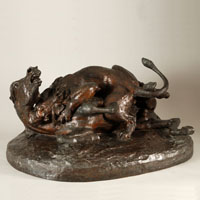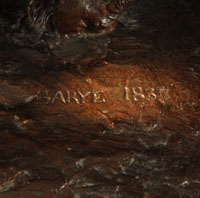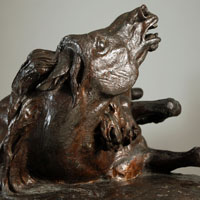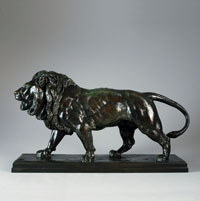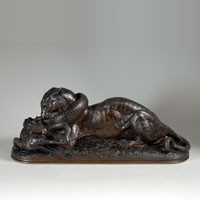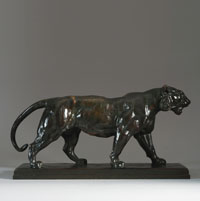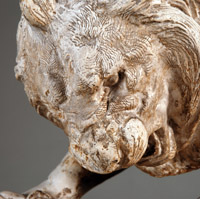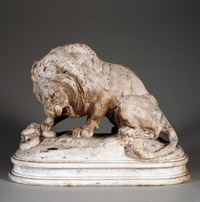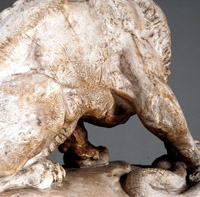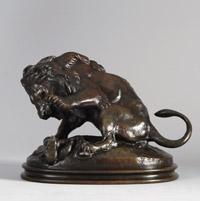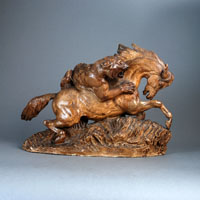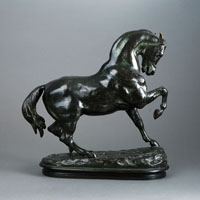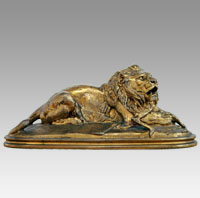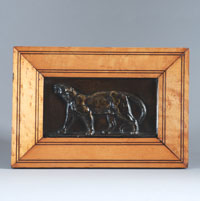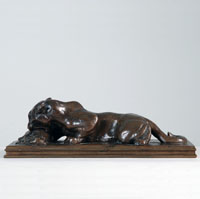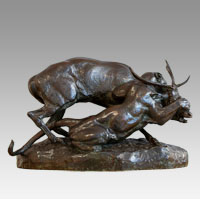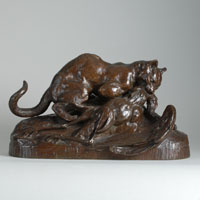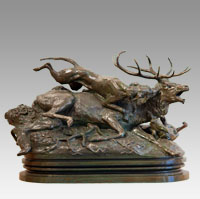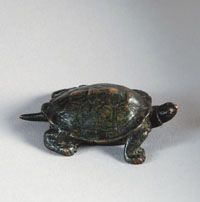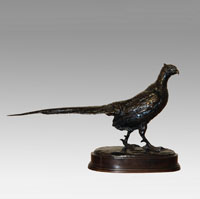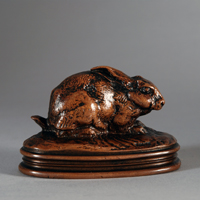Born in Paris, Antoine-Louis Barye was the son of a goldsmith, Pierre Barye. The younger Barye started to study at the Ecole des Beaux-Arts in 1818 under the neo-classical sculptor Bosio and the romantic painter Gros.
In 1823, Barye worked for the goldsmith Fauconnier, modelling small animals. In 1831, Barye was the first to exhibit animals at the Salon with his famous "Tiger devouring a Gavial". Barye is known as the master of the Animalier School of Sculpture.
Antoine-Louis Barye was dubbed the "Michelangelo of the Menagerie" by the celebrated art critic, Théophile Gautier, in the revue l’Illustration, May 1866. His work was in the spirit of Romanticism, characterized by violent movement and tense posture. Barye also created the pediment "Napoleon dominating History and the Arts" on the Pavilion de l'Horloge of the Louvre and an equestrian statue of Napoleon at Ajaccio, the Emperor's birthplace in Corsica.
Barye’s lifetime editions were divided into three periods. During the first period between 1838 and 1845, Barye was his own editor and often founder as well, although he used other founders such as de Braux, Soyer and Eck & Durand. A catalogue of 47 models published by the Maison Besse also falls within this aera.
In the second period from 1845 to 1857 Barye entered into an association with the engineer Emile Martin. Three catalogues of his works were published before the arrangement ended. In the last period of time 1857-1875, Barye took back full control of his models. During this period, Barye created his most beautiful and subtle patinations and four other catalogues were published.
Finally in 1876, after the death of the artist, Barye’s art studio was sold at the Hôtel Drouot and the main foundry as Barbedienne, Brame or Delafontaine bought the plaster models with the rights to make posthumous editions.
It is possible to learn more about the greatest Animalier in reading the biography written by Michel Poletti – Monsieur Barye, editions Acatos- and the recent catalogue raisonné of his work, co-authored by Michel Poletti and Alain Richarme, Gallimard Editions, 2000.
Works by Antoine-Louis Barye
Antoine-Louis BARYE (1795-1875)
Bibliography
ALEXANDRE, Arsène, Les Artistes célèbres, Antoine-Louis BARYE, Paris, 1889.
BALLU, Roger, L'œuvre de BARYE, Paris 1890, préface d'Eugène GUILLAUME, BARYE théoricien.
BAILLO, J, The wild Kingdom of BARYE, 1994.
BENGE, Glenn F., The sculpture of Antoine Louis BARYE in American Collections, With a Catalogue Raisonné, Iowa, The University of Iowa, 2 vol. 1969.
BENGE,Glenn F., Antoine Louis Barye (1796-1875), Cambridge, 1975, pp. 89-107.
BENGE, G. F., Antoine-Louis BARYE Sculptor of Romantic Realism, 1984.
GRAHAM & SON, Antoine-Louis BARYE and the American collector, 2004.
GRIMAUDET, Blandine de, Barye sera toujours Barye, in Beaux-Arts Magazine, sept. 1992, n°104.
HUBERT, Gérard, BARYE et la critique de son temps, in Revue des Arts, Décembre 1956, n°4, pp.223-230.
JOHNSTON, William R. and KELLY, Simon, Untamed, The Art of Antoine-Louis Barye, The Walters Art Museum, Prestel, 2006.
LEMAISTRE, I., La griffe et la dent, Antoine-Louis BARYE, 1996.
LOFFREDO, François-Raphaël, L'inventaire après décès d'Antoine-Louis Barye, in Archives de l'Art Français, 1989, t.XXX, pp. 143-154.
MANNONI, E., BARYE, Editions de l'Amateur, 1996.
OTTO ZIESENISS, Les aquarelles de BARYE, 1954.
PILLET, C (C.P.), Œuvres de Feu BARYE, 1876.
PIVAR, Stuart, The BARYE Bronzes, Woodbridge, Suffolk, Antique Collector's Club, 1981 (Réédition 1981 et 1990.)
POLETTI, Michel et RICHARME, Alain, A.L. BARYE, artiste et artisan, Paris, Univers du Bronze, 1992.
POLETTI, Michel et RICHARME Alain, A.L. BARYE, Catalogue raisonné des sculptures, Gallimard, Paris, 2000.
POLETTI, Michel, Monsieur BARYE, Paris, Editions Acatos, 2002.
SAUNIER, Charles, BARYE, Paris, Edidtions Rieder, 1925.
The SLADMORE GALLERY, Exhibition of sculpture by A.-L. BARYE, London, 1972.
SELLIER, M, BARYE, des mains pour créer (3 ex.), 2003.
WASSERMAN, J., Sculpture by Antoine-Louis BARYE, Fogg Art Museum, 1982.
WILDENSTEIN FONDATION, The Kingdom of Barye, New York, 1994.
BALLU, Roger, L'œuvre de BARYE, Paris 1890, préface d'Eugène GUILLAUME, BARYE théoricien.
BAILLO, J, The wild Kingdom of BARYE, 1994.
BENGE, Glenn F., The sculpture of Antoine Louis BARYE in American Collections, With a Catalogue Raisonné, Iowa, The University of Iowa, 2 vol. 1969.
BENGE,Glenn F., Antoine Louis Barye (1796-1875), Cambridge, 1975, pp. 89-107.
BENGE, G. F., Antoine-Louis BARYE Sculptor of Romantic Realism, 1984.
GRAHAM & SON, Antoine-Louis BARYE and the American collector, 2004.
GRIMAUDET, Blandine de, Barye sera toujours Barye, in Beaux-Arts Magazine, sept. 1992, n°104.
HUBERT, Gérard, BARYE et la critique de son temps, in Revue des Arts, Décembre 1956, n°4, pp.223-230.
JOHNSTON, William R. and KELLY, Simon, Untamed, The Art of Antoine-Louis Barye, The Walters Art Museum, Prestel, 2006.
LEMAISTRE, I., La griffe et la dent, Antoine-Louis BARYE, 1996.
LOFFREDO, François-Raphaël, L'inventaire après décès d'Antoine-Louis Barye, in Archives de l'Art Français, 1989, t.XXX, pp. 143-154.
MANNONI, E., BARYE, Editions de l'Amateur, 1996.
OTTO ZIESENISS, Les aquarelles de BARYE, 1954.
PILLET, C (C.P.), Œuvres de Feu BARYE, 1876.
PIVAR, Stuart, The BARYE Bronzes, Woodbridge, Suffolk, Antique Collector's Club, 1981 (Réédition 1981 et 1990.)
POLETTI, Michel et RICHARME, Alain, A.L. BARYE, artiste et artisan, Paris, Univers du Bronze, 1992.
POLETTI, Michel et RICHARME Alain, A.L. BARYE, Catalogue raisonné des sculptures, Gallimard, Paris, 2000.
POLETTI, Michel, Monsieur BARYE, Paris, Editions Acatos, 2002.
SAUNIER, Charles, BARYE, Paris, Edidtions Rieder, 1925.
The SLADMORE GALLERY, Exhibition of sculpture by A.-L. BARYE, London, 1972.
SELLIER, M, BARYE, des mains pour créer (3 ex.), 2003.
WASSERMAN, J., Sculpture by Antoine-Louis BARYE, Fogg Art Museum, 1982.
WILDENSTEIN FONDATION, The Kingdom of Barye, New York, 1994.
